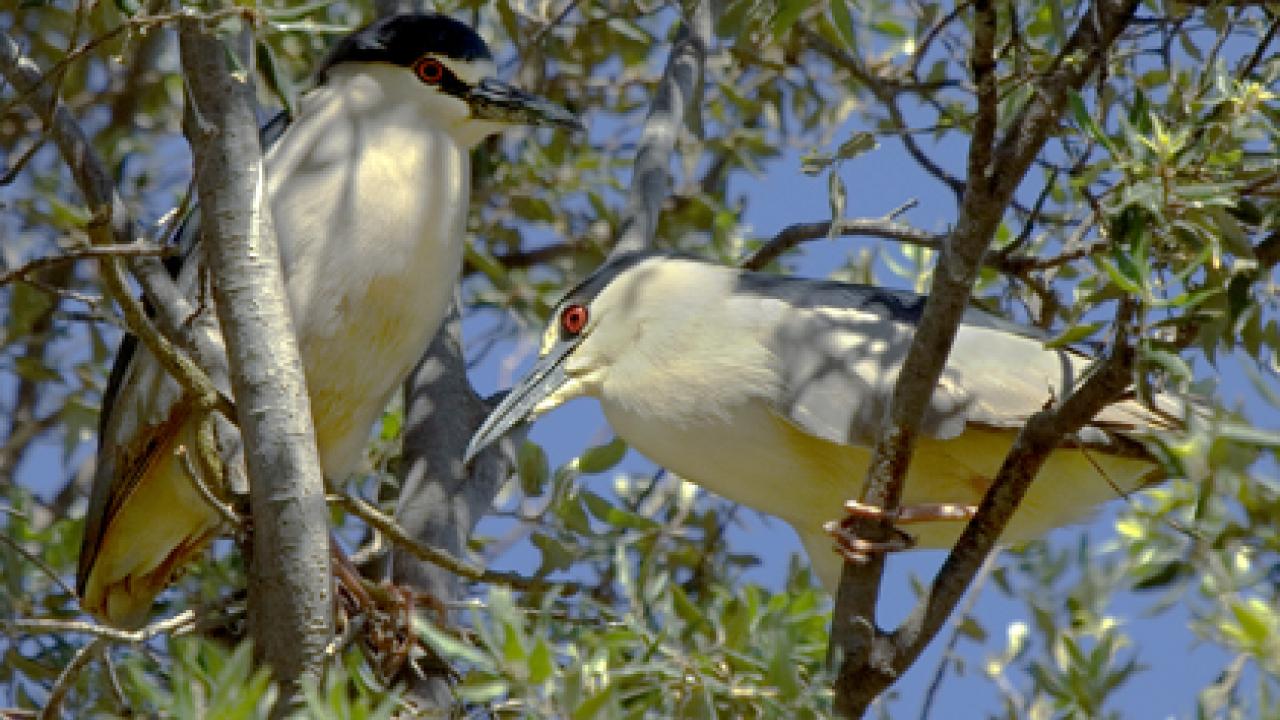A program that successfully discouraged egrets and herons from nesting in the campus's Shields Oak Grove will continue this year, with slight variations.
When the first black-crowned night-herons arrive (could be any day now), they will be greeted with disturbing but harmless fireworks and laser lights, said Emily Griswold, assistant director of horticulture for the arboretum and a member of the arboretum oak and wildlife management team.
To reduce the staff workload and to focus on the most effective methods to discourage nesting, this year the wildlife management team will operate with reduced hours and will not be playing recorded bird distress calls.
The annoyances will persist, at dusk and dawn, as long as the big birds continue landing in the oak trees. Based on the annual pattern seen in the nine years since the first nests were built, the team expects to have to shoo away two overlapping waves of birds — night-herons, snowy egrets and great egrets followed by a large and prolonged wave of cattle egrets.
The Shields Oak Grove was established at the arboretum's west end in 1962. The big, wading birds began using the trees as a rookery — a place to nest and raise offspring — in 2000. Each year, their nests became more numerous and spread over a larger area of the grove. In 2006, there were 631 nests; in 2008, there were 866.
In addition to the rookery, the Shields grove also became a roost for non-nesting birds after the breeding season. While the rookery numbers steadily rose, the roost numbers fluctuated widely, for unknown reasons. In 2007, there were 800 birds simply roosting in the grove; in 2008, there were only a handful.
What began as an interesting wildlife spectacle became a serious threat to the oak trees' health, largely because of the toxic qualities of the birds' excrement, or guano, Griswold has said.
"Ammonia is toxic and causes defoliation. Guano is opaque, so it blocks photosynthesis and causes defoliation. Salts stunt the growth of roots and shoots, and cause marginal burn on the leaves and defoliation," Griswold summed up the problem in 2008.
Complete defoliation of a branch over several years kills the branch. Dead branches can lead to weak and dying trees — not an option for the oak grove, which is a resource for scholars and conservationists, as well as recreational visitors. It contains the largest collection of mature oaks in the southwestern United States — 304 trees representing 87 types of oak species, varieties and hybrids, some of which are rare and endangered. It is a partner in the national oak collection of the prestigious North American Plant Collections Consortium.
In past years, in the hope of a sustainable balance for both trees and birds, the arboretum oak and wildlife management team has tested a variety of nesting deterrents: structural pruning of trees; removing some redundant and crowding trees; removing the remnants of previous years' nests; and tying shiny Mylar streamers and balloons to the treetops.
The rookery kept growing despite these efforts, so in 2009 a new approach was taken.
"No single method alone had been shown to be effective in deterring colonial-nesting birds, so we needed to throw a suite of tactics at them," said Andy Engilis, curator of the UC Davis Museum of Wildlife and Fish Biology, and the wild bird expert on the team. "In 2009, we used laser lights in combination with bird distress calls broadcast from loudspeakers, human presence, and small, noisemaking fireworks." The strategy worked, and no nesting occurred.
As in past years, the plan is that if any birds are resolute enough to lay eggs, the entire deterrent program will stop, in order to prevent any chick deaths, Engilis said.
"The keys to success are diversity of methods, timing, persistence and organization," he concluded. "The university is committed to finding a solution that works for both birds and trees."
SHARE YOUR OAK STORIES: No, not the ones having to do with egrets and herons. But stories about how oaks have played meaningful roles in your life, in the arboretum or anywhere else. See story.
Media Resources
Dave Jones, Dateline, 530-752-6556, dljones@ucdavis.edu
